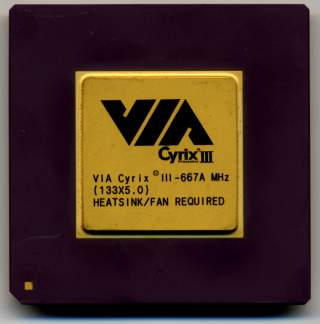The New VIA Cyrix III: The Worlds First 0.15 Micron x86 CPU
by Matthew Witheiler on January 5, 2001 12:01 PM EST- Posted in
- CPUs
The Samuel2 Core
There is no question that the original Samuel core that powered some Cyrix III chips had some fundamental problems. In order to salvage face, if at all possible, some major changes needed to be implemented in the new Samuel2 core. It had to be cool, have a low power draw, be very cost competitive, and most of all be somewhat powerful.
Many of the aforementioned requirements were met in a manner that one does not typically consider: a fab shrink. Normally this method of reducing cost, decreasing heat, and decreasing price is usually not mentioned since fab shrinks do not come very often. Luckily for VIA, the company was able to start production of the Samuel2 on a 0.15 micron process, making the Samuel2 core the worlds first 0.15 micron x86 CPU.
In terms of manufacturing process, the Samuel2 core is quite revolutionary. Even Intel and AMD's latest offerings are 0.18 micron based, including the newly released Pentium 4. What difference does this smaller manufacturing process make?
By decreasing the size of the transistors in the chip, voltage, current, and thus power were also decreased. By decreasing these elements, both the heat associated with the items as well as the power required to operate the transistors are decreased.
We know heat as an enemy because it decreases the operational range of the transistors inside a processor. By shrinking the process on which the Samuel II is produced, VIA paved the way to higher clock speed Cyrix III processors. It is therefore no surprise that we will see the initial Samuel2 based Cyrix III processors running at 700 MHz and higher. In addition, hitting 1.0 GHz should be no problem with such a small process.
As mentioned before, power consumption is also reduced when manufacturing process is shrunk. This allows the Samuel2 based Cyrix III to further penetrate the ultra portable market where low power consumption is key. The Samuel2 based Cyrix III runs off a low 1.5 volts and requires only 4.5 watts of power for a 600 MHz clock speed and 5.1 watts for the 700 MHz clock speed. This is far lower than Intel solutions. The mobile Celeron 600 MHz (which operates at 1.6 volts), for example, requires 5.8 watts to run. Even a difference of .1 watts is beneficial when it comes to extending battery life.
In addition, the low power consumption of the Samuel2 results in much lower operating temperature. The .15 micron process is to thank for that and does provide the Samuel2 based Cyrix III with an advantage. VIA claims that the chip will perform flawless with only a heatsink. Once again, this allows the Samuel2 core to penetrate ultra portable devices, where space and power requirements do not allow for a cooling fan.
Finally, the price of a chip is reduced, for the most part, when the manufacturing processes is shrunk. Since decreasing the manufacturing process decreases the die size of a chip, less silicon is necessary to produce a chip of an equal transistor count. In the case of the 0.15 micron Samuel2 core the die measures a tiny 52 mm^2, only 69% the size of the original 0.18 micron Samuel and about half the size of Coppermine128 core used in the newest Intel Celeron processors.












0 Comments
View All Comments